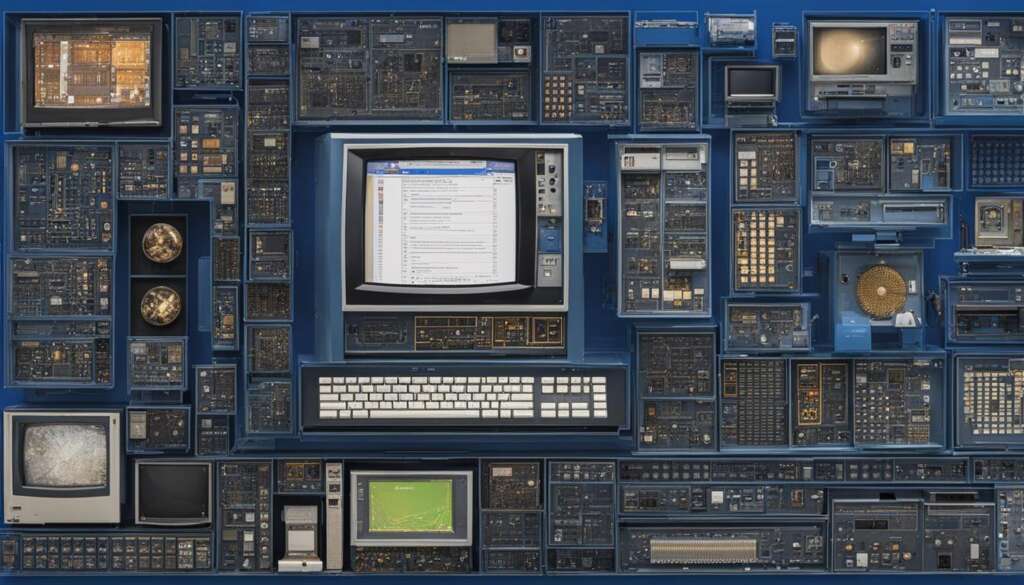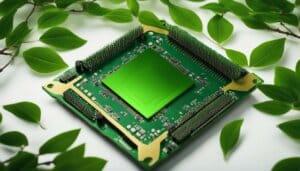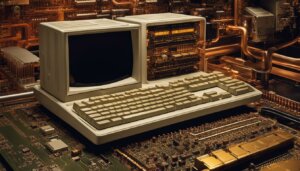Table of Contents
Embedded processors have revolutionized everyday devices, powering advanced functionalities such as NLP, AI, and machine learning. These processors, combined with hardware and software components, enable technologies like the Internet of Things (IoT) and edge computing.
Designed for real-time systems, embedded processors respond to feedback and events, making them essential for firmware development. They excel in parallel processing and consume low power, ensuring optimal performance while conserving energy.
This article explores the evolution of embedded processors, their impact on everyday devices, and their role in shaping the future of technology. From the development of the Apollo Guidance Computer to the integration of AI, embedded processors have transformed ordinary devices into smart, interconnected systems.
What are Embedded Systems?
Embedded systems are dedicated computing systems designed to perform specific tasks. Unlike personal computers (PCs), which have general-purpose capabilities, embedded systems have focused hardware and software components. These systems can be found in a wide range of devices, from washing machines and routers to vehicles and medical devices.
Embedded systems operate using small amounts of memory and processing power to efficiently carry out their dedicated tasks. Some embedded systems use a single microprocessor, while others utilize multiple core processors. In addition to microprocessors, embedded systems also incorporate other essential hardware components such as sensors and actuators to interact with the external environment.
“Embedded systems are dedicated computing systems designed to perform specific tasks, with focused hardware and software components.”
In terms of software, embedded systems can use different types of operating systems. Some systems, especially low-end microcontrollers, may run directly on the hardware without an operating system. Others may use real-time operating systems (RTOS) that provide features such as multitasking and software timers. Embedded operating systems, including Embedded Linux, can also be used, providing a specific set of tasks or a full-fledged OS tailored for the device’s requirements.
Table: Comparison of Embedded Systems
| Aspect | Bare Metal | Real-Time Operating Systems (RTOS) | Embedded Operating Systems |
|---|---|---|---|
| Memory and Processing Power | Low | Varies | Varies |
| Tasks | Specific | Specific | Specific |
| Features | Minimal | Multitasking, timers | Tailored functionality |
| Scalability | Low | Medium | High |
The table above provides a comparison of different types of embedded systems, highlighting their differences in memory and processing power, tasks, features, and scalability.
The History of Embedded Systems and Charles Stark “Doc” Draper
The development of embedded systems can be traced back to the groundbreaking work of Charles Stark “Doc” Draper in the 1960s. Draper, an expert in inertial navigation, played a pivotal role in the creation of the Apollo Guidance Computer (AGC), the first modern embedded system. Installed on board each Apollo command module and lunar module, the AGC revolutionized the navigation of spacecraft, enabling successful moon landings and human exploration beyond Earth.
At the heart of the AGC were motion sensors and navigation algorithms that allowed precise control of the spacecraft. The incorporation of embedded systems in the Apollo program marked a significant milestone in the history of technology, showcasing the potential of these systems to achieve complex tasks in real-time.
The development of the Apollo Guidance Computer paved the way for the widespread use of embedded systems in various industries, fueling advancements in fields such as automotive, healthcare, and consumer electronics.
Embedded systems have come a long way since the AGC, evolving to become smaller, more powerful, and capable of performing advanced functions. Today, they are ubiquitous in our daily lives, powering a wide range of devices and enabling technologies such as artificial intelligence, machine learning, and the Internet of Things. The contributions of Charles Stark Draper and the AGC continue to shape the evolution of embedded systems, driving innovation and transforming the way we interact with technology.
The Legacy of Charles Stark Draper: The Apollo Guidance Computer (AGC)
Table: Impact of the Apollo Guidance Computer (AGC)
| Application | Impact |
|---|---|
| Apollo Command Module | Enabled accurate navigation and control of the spacecraft during missions to the moon. |
| Lunar Excursion Module | Facilitated safe landings on the moon’s surface and precise liftoffs for rendezvous with the command module. |
The Evolution of Embedded Systems
Since the development of the Apollo Guidance Computer (AGC) in the 1960s, embedded systems have undergone significant evolution, leading to their widespread use in various industries. One key advancement in the field of embedded processors was the introduction of microprocessors like the Intel 8008 and Motorola MC6800 in the 1970s. These powerful processors paved the way for the development of more versatile and capable embedded systems.
Today, embedded systems are found in a wide range of applications, including automotive systems, mobile phones, industrial machines, and medical equipment. These systems have become more sophisticated and capable, integrating technologies such as AI, machine learning, and edge computing. With millions of lines of code, modern embedded systems are able to perform complex tasks and enhance user experiences.
To illustrate the evolution of embedded systems, let’s take a look at a comparison table:
| AGC (1960s) | Intel 8008 (1972) | Motorola MC6800 (1974) | Modern Embedded Systems | |
|---|---|---|---|---|
| Processing Power | 2.048 MHz clock speed | 0.8 MHz clock speed | 0.92 MHz clock speed | Multi-core processors, clock speeds up to GHz |
| Memory | 2.048 KB of RAM | 128 bytes of RAM | 128 bytes of RAM | MBs to GBs of RAM |
| Applications | Apollo Guidance System | Calculators, cash registers | Industrial control systems | Automotive systems, smartphones, medical equipment |
As shown in the table, embedded systems have significantly evolved in terms of processing power, memory capacity, and applications over the years. From the AGC’s role in the Apollo missions to the advanced capabilities of modern embedded systems, they continue to drive innovation and transform various industries.
Differences Between Bare Metal, Real-Time Operating Systems, and Embedded Operating Systems
Embedded systems utilize different types of operating systems, each tailored to specific requirements and tasks. Understanding the differences between bare metal, real-time operating systems (RTOS), and embedded operating systems is essential in developing efficient and scalable embedded systems.
Bare Metal
Bare metal refers to programming code that runs directly on the hardware without an operating system. It is ideal for low-end microcontrollers and offers maximum control and minimal overhead. With bare metal, developers have direct access to hardware resources, allowing for tight integration and performance optimization. However, bare metal systems lack the convenience of an OS, requiring developers to handle tasks such as memory management and device drivers manually.
Real-Time Operating Systems
Real-time operating systems (RTOS) are designed for applications that require precise timing and responsiveness. They offer multitasking capabilities, enabling multiple tasks to run concurrently, and provide mechanisms for handling real-time events and deadlines. RTOS can be categorized as hard real-time or soft real-time, depending on the strictness of timing guarantees. Hard real-time systems ensure that critical tasks are completed within specified deadlines, while soft real-time systems prioritize critical tasks but allow some flexibility in meeting deadlines.
Embedded Operating Systems
Embedded operating systems, such as Embedded Linux or proprietary systems, are designed specifically for embedded systems. They provide a higher-level abstraction compared to bare metal, offering features such as file systems, networking stacks, and device drivers. Embedded operating systems allow for easier development and maintenance of embedded systems by leveraging existing software libraries and tools. They range from lightweight stripped-down versions of Linux to full-fledged operating systems like Windows Embedded, providing scalability based on the specific requirements of the embedded system.
Choosing the right type of operating system depends on factors such as the nature of the embedded system, resource constraints, real-time requirements, and development complexity. Bare metal systems offer maximum control and efficiency but require manual handling of system-level tasks. RTOS are suitable for time-critical applications with complex task scheduling needs. Embedded operating systems provide a higher level of abstraction and ease of development but may introduce additional overhead. By understanding the strengths and limitations of each type, developers can make informed decisions to build robust and optimized embedded systems.
The First Embedded Operating Systems and Their Impact
The late 1970s marked the introduction of the first embedded operating systems, paving the way for significant advancements in the field. Two notable operating systems emerged during this time: VRTX32 and VxWorks. VRTX32, developed by Hunter and Ready, was a real-time operating system designed for microprocessors. It offered features such as preemption and multitasking, making it suitable for applications that required precise timing and responsiveness. VxWorks, developed by Wind River Systems, also provided real-time capabilities and became widely used in industries such as aerospace and defense.
In 1996, Microsoft made its entry into the embedded marketplace with Windows Embedded CE. This operating system brought the familiarity and compatibility of Windows to embedded devices, enabling developers to leverage existing knowledge and tools. Around the same time, embedded Linux products began to emerge, offering a flexible and customizable solution for embedded systems. The introduction of these operating systems laid the foundation for the integration of embedded systems into various domains.
“The first embedded operating systems revolutionized the industry, enabling the development of highly reliable and efficient embedded systems. They opened up possibilities for industries such as aerospace, defense, and consumer electronics, providing the foundation for the advanced technologies we use today.” – Expert in embedded systems development
The impact of embedded operating systems became even more apparent with the advent of smartphones. The release of the iPhone in 2007 and the first Android phone in 2008 marked a significant milestone in the integration of embedded systems into mobile devices. These smartphones featured sophisticated operating systems, such as iOS and Android, that seamlessly combined communication, multimedia, and computing capabilities. The introduction of embedded operating systems in smartphones transformed them into powerful, multipurpose devices that have become an essential part of our daily lives.
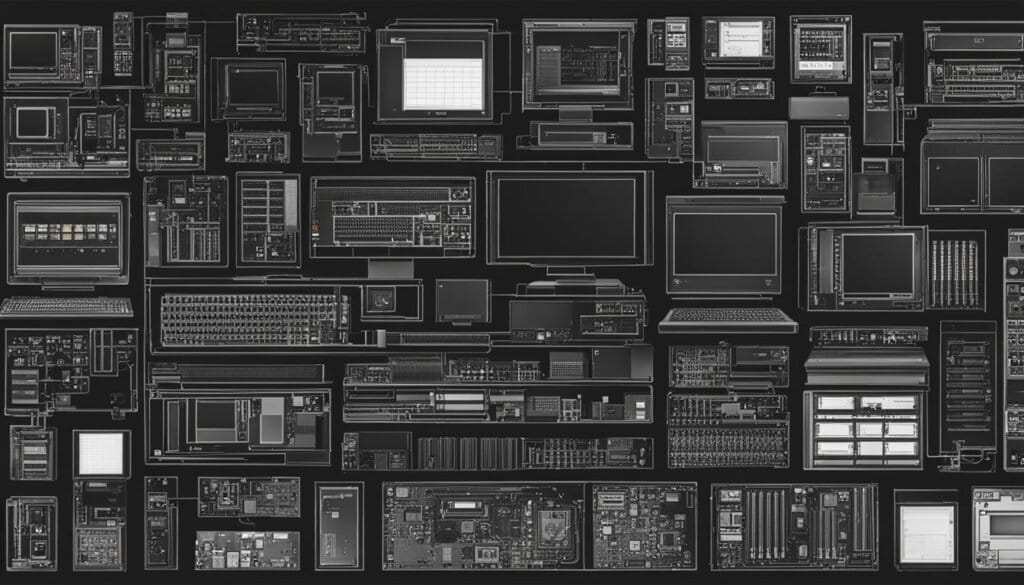
Table: Evolution of Embedded Operating Systems
| Operating System | Year Introduced | Key Features |
|---|---|---|
| VRTX32 | Late 1970s | Real-time capabilities, preemption, multitasking |
| VxWorks | 1987 | Real-time capabilities, widely used in aerospace and defense |
| Windows Embedded CE | 1996 | Compatibility with Windows, familiar development environment |
| Embedded Linux | 1990s | Flexible, customizable, open-source |
| iOS | 2007 | Sophisticated operating system for iPhone |
| Android | 2008 | Open-source operating system for smartphones |
Characteristics and Structure of Embedded Systems
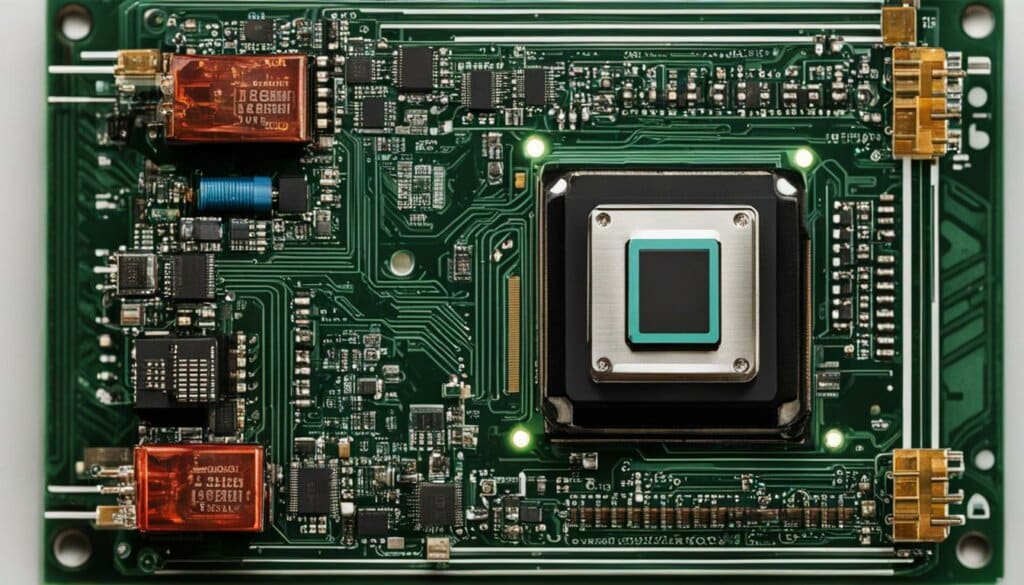
Embedded systems possess unique characteristics that distinguish them from general-purpose computing systems. They consist of hardware, software, and firmware components, each playing a critical role in their functionality. The hardware component includes microprocessors and microcontrollers, which serve as the processing units for embedded systems. These processors are responsible for executing the tasks assigned to the embedded system.
The software and firmware components control the hardware and perform the specific tasks assigned to the embedded system. Software provides the necessary instructions and algorithms, while firmware is the permanent software programmed onto the system’s read-only memory. Together, software and firmware enable the embedded system to operate and fulfill its dedicated functions.
Structure of Embedded Systems
The structure of embedded systems involves the integration of sensors, converters, processors, and actuators. Sensors are used to gather data from the environment, converting physical or analog phenomena into digital signals that can be processed by the embedded system. Processors analyze the data obtained from the sensors and perform the necessary computations to generate appropriate responses.
The actuators then receive the output from the processors and convert them into physical actions or responses. These actions can include motor movements, adjustments to operating conditions, or any other appropriate response based on the intended function of the embedded system. This hierarchical arrangement of sensors, converters, processors, and actuators enables embedded systems to efficiently convert input into useful output, ensuring reliable performance.
| Components | Functions |
|---|---|
| Hardware | Microprocessors, microcontrollers |
| Software | Instructions, algorithms |
| Firmware | Permanent software programmed onto read-only memory |
| Sensors | Gather data from the environment |
| Processors | Analyze data and perform computations |
| Actuators | Convert output into physical actions or responses |
By understanding the characteristics and structure of embedded systems, we gain insights into their design and functionality. These systems, with their combination of hardware, software, and firmware, work together to perform specific tasks efficiently and reliably. Whether it is in the automotive, healthcare, or consumer electronics industry, embedded systems continue to impact our everyday lives, enabling the development of smart, interconnected devices that enhance our modern world.
Types of Embedded Systems and Their Applications
Embedded systems come in various types, each designed for specific purposes and applications. Understanding these different types is crucial to leveraging their capabilities effectively. Here, we explore the four main categories of embedded systems: Mobile Embedded Systems, Networked Embedded Systems, Standalone Embedded Systems, and Real-Time Embedded Systems.
Mobile Embedded Systems
Mobile embedded systems are designed to be portable and are commonly found in devices such as smartphones, tablets, and wearable technology. These systems are optimized for size, power consumption, and efficient processing to cater to the demands of mobile devices. With the increasing popularity of mobile apps and smart devices, mobile embedded systems play a vital role in enhancing user experience and providing advanced functionalities.
Networked Embedded Systems
Networked embedded systems are connected to a network and interact with other devices or systems. These systems take advantage of wired or wireless connectivity to communicate and exchange data. They are widely used in applications like home automation, industrial control systems, and smart cities. Networked embedded systems enable seamless integration and coordination between devices, contributing to the growth of the Internet of Things (IoT) ecosystem.
Standalone Embedded Systems
Standalone embedded systems are designed to perform specialized tasks independently, without relying on a host system. These systems are commonly found in devices like calculators, digital cameras, and MP3 players. Standalone embedded systems are tailored to specific functions, providing dedicated features and ensuring optimal performance for their intended purposes.
Real-Time Embedded Systems
Real-time embedded systems are time-critical and require precise timing. These systems are commonly used in sectors such as medical, industrial control, and military applications. Real-time embedded systems often operate in environments where timing accuracy is crucial, performing tasks in response to real-world events within specified time constraints.
| Type of Embedded System | Applications |
|---|---|
| Mobile Embedded Systems | Smartphones, tablets, wearable technology |
| Networked Embedded Systems | Home automation, industrial control systems, smart cities |
| Standalone Embedded Systems | Calculators, digital cameras, MP3 players |
| Real-Time Embedded Systems | Medical devices, industrial control, military applications |
Advancements in Embedded Systems and their Impact on Everyday Life
Embedded systems have undergone significant advancements in recent years, bringing about a transformation in our everyday lives. The integration of artificial intelligence (AI) into embedded systems has paved the way for the development of smart devices that can perform complex functions autonomously. From smart home systems that can control lighting and temperature to autonomous vehicles that can navigate and make decisions on their own, these advancements have revolutionized the way we interact with technology.
One of the key advantages of AI integration in embedded systems is the improved efficiency it offers. With AI algorithms and machine learning capabilities, embedded systems can optimize their operations and adapt to changing conditions in real-time. For example, AI-powered thermostats can learn user preferences and adjust temperatures accordingly, resulting in energy savings and enhanced comfort. Similarly, AI-powered surveillance systems can detect abnormal activities and trigger alerts, enhancing security and reducing false alarms.
Embedded systems have also significantly enhanced the user experience. With AI integration, devices can understand and respond to user inputs, making interactions more intuitive and natural. Voice assistants, like Amazon’s Alexa and Apple’s Siri, have become a common feature in many households, allowing users to control various devices using voice commands. These smart devices have made tasks more convenient and streamlined, creating a seamless user experience.
The impact of advancements in embedded systems goes beyond individual devices. The integration of AI has enabled the creation of interconnected devices in the Internet of Things (IoT) ecosystem. This interconnectedness allows for seamless communication and data exchange between devices, leading to a more integrated and cohesive technological environment. For example, a smart home system can communicate with a wearable device to adjust lighting and temperature settings based on the user’s preferences and location. This integration offers convenience, efficiency, and personalized experiences that were not possible before.

Table: Examples of AI-Integrated Embedded Systems
| Device | Functionality | Impact |
|---|---|---|
| Smart Thermostat | Optimizes temperature settings based on user preferences and occupancy patterns | Energy savings and enhanced comfort |
| Autonomous Vehicles | Navigate and make decisions based on real-time data to improve road safety and efficiency | Reduced accidents and congestion |
| Smart Home Systems | Control lighting, appliances, and security using voice commands and AI algorithms | Convenience and enhanced security |
| Wearable Devices | Monitor health parameters and provide personalized insights and recommendations | Improved health monitoring and management |
Total Phase’s Support for Debugging and Developing Embedded Systems
Total Phase, a leading provider of embedded systems development tools, offers a range of hardware and software products to support debugging and development efforts. Their offerings include I2C/SPI host adapters, protocol analyzers, and a CAN interface, all designed to streamline the development process and ensure optimal performance.
1. I2C/SPI Host Adapters
Total Phase’s I2C/SPI host adapters are indispensable tools for embedded systems developers. These adapters allow for easy programming of memory devices and emulation of I2C/SPI systems. With their user-friendly interface and reliable performance, developers can efficiently interface with various devices, reducing development time and ensuring compatibility. Total Phase offers a range of host adapters, catering to different needs and specifications.
2. Protocol Analyzers
Embedded systems development often requires real-time monitoring of bus traffic, ensuring smooth communication and identifying protocol errors or bugs. Total Phase’s protocol analyzers provide developers with the tools they need to analyze and debug their systems with ease. These analyzers offer real-time monitoring of I2C, SPI, USB, and other protocols, enabling developers to pinpoint issues quickly and efficiently. By capturing and analyzing bus traffic, developers can gain valuable insights into their system’s performance and troubleshoot any potential problems.
3. CAN Interface
For developers working with CAN (Controller Area Network) systems, Total Phase offers a versatile CAN interface that serves as both a bus monitor and an active CAN adapter. This interface provides developers with the ability to accurately monitor and analyze CAN bus traffic in real-time. It also allows for direct communication with CAN devices, enabling developers to send and receive messages efficiently. With Total Phase’s CAN interface, developers can ensure the reliability and optimal performance of their embedded systems.
By providing robust tools for debugging and development, Total Phase empowers embedded systems developers to create reliable, high-performance solutions. Their I2C/SPI host adapters, protocol analyzers, and CAN interface are essential components of any developer’s toolkit, facilitating efficient development and reducing time to market. With Total Phase’s support, developers can confidently navigate the complex world of embedded systems and bring their innovative ideas to life.
Conclusion
Embedded processors have had a profound impact on the transformation of everyday devices, bringing intelligence and connectivity to our lives. These processors, with their increased power and advanced functionalities, have revolutionized industries such as automotive, healthcare, and consumer electronics. They have enabled the development of smart devices that enhance efficiency and provide enhanced user experiences.
Looking ahead, the future of embedded systems is promising. With the integration of artificial intelligence, machine learning, and edge computing, these systems will continue to evolve and drive innovation. The possibilities are endless, and embedded systems will shape the technology landscape and impact our everyday lives in even more profound ways. We can expect to see further advancements in various aspects of our lives, from smart homes to autonomous vehicles.
In conclusion, embedded processors have been instrumental in the ongoing transformation of ordinary devices into interconnected, smart systems. The impact of embedded systems is evident in the way technology has evolved and continues to enhance our daily lives. As we move forward, embedded systems will play a pivotal role in shaping the future of technology and improving various aspects of our lives.
FAQ
What are embedded systems?
Embedded systems are dedicated computing systems designed to perform specific tasks. They consist of hardware and software components and are found in a wide range of devices, such as washing machines, vehicles, and medical devices.
How have embedded systems evolved over time?
Embedded systems have become smaller and more powerful, enabling advanced functionalities like NLP, AI, and machine learning. They have also played a pivotal role in the growth of technologies like the Internet of Things (IoT) and edge computing.
What is the history of embedded systems?
The concept of embedded systems dates back to the Apollo Guidance Computer (AGC), developed by Charles Stark “Doc” Draper. The AGC was the first modern embedded system and played a crucial role in navigating the Apollo spacecraft to the moon.
What are the different types of embedded operating systems?
There are several types of embedded operating systems, including bare metal systems, real-time operating systems (RTOS), and embedded Linux or proprietary systems. They vary in functionality and are designed for specific tasks and requirements.
How have embedded systems impacted everyday life?
Embedded systems have transformed ordinary devices into smart, interconnected systems. They have improved efficiency, enhanced user experiences, and enabled the development of advanced functionalities like AI and machine learning.
What support does Total Phase offer for debugging and developing embedded systems?
Total Phase offers a range of hardware and software products, including I2C/SPI host adapters, protocol analyzers, and CAN interfaces. These tools help developers debug and develop their embedded systems for optimal performance.

